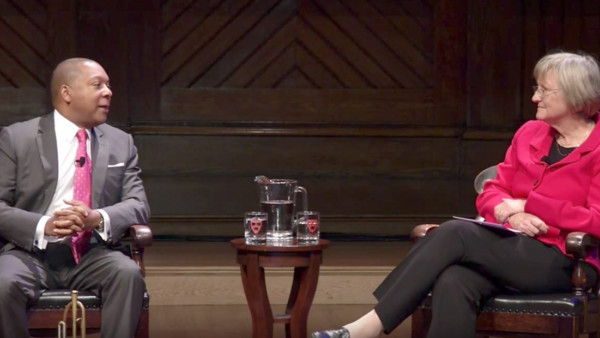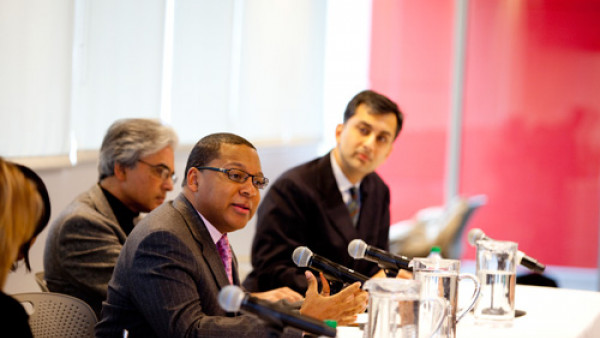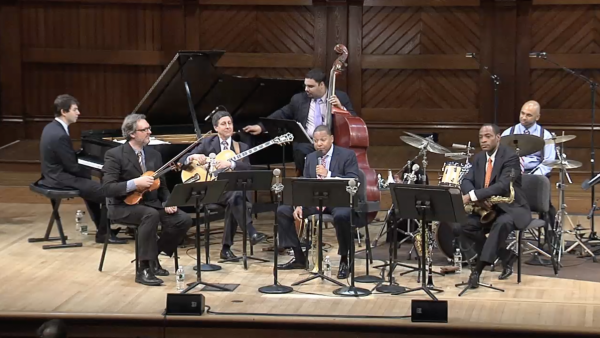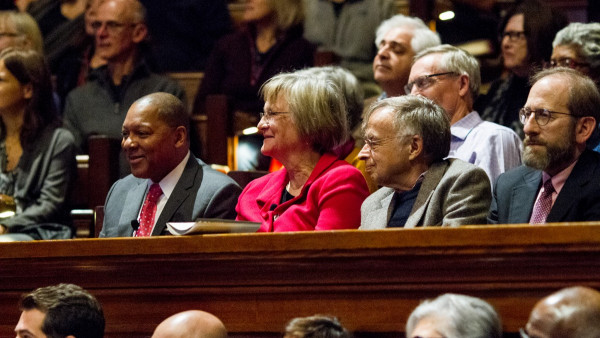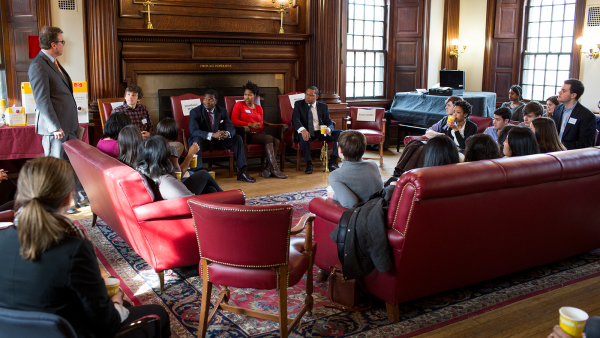Can Wynton Marsalis and Lincoln Center Save Jazz Music?
Research says that people imprint on music in their dating years, and carry those tastes with them through the rest of their lives. Lately, this has spelled trouble for jazz music, which is failing to attract new and younger fans in a competitive musical landscape. With its listenership in steep decline, jazz legend Wynton Marsalis is looking to rebrand the genre and engineer its comeback, with the help of Professor Rohit Deshpande.
TRANSCRIPT:
Brian Kenny: According to Nielsen’s 2014 year-end report, the popularity of jazz has hit an all-time low. At the time of the report both jazz and classical represented just 1.4 percent of total music consumption in the US. In real numbers, that’s 5.2 million albums sold by all jazz artists combined in 2014. Compare that to the best-selling artist of 2014, Taylor Swift. She sold 3.7 million copies of her latest album, “1989,” in the last two months of 2014 alone.
How is it that this uniquely American form of music, the soundtrack for the first half of the 20th century, has fallen so far? More importantly, can it be revived? Today we’ll hear from Professor Rohit Deshpandé about his case study entitled “Wynton Marsalis and Jazz at the Lincoln Center.”
Professor Deshpandé is an expert in global branding and international marketing. He teaches both executives and MBA students here at Harvard Business School, and I’m going to guess you’re a jazz fan. Rohit, thanks for joining me.
Rohit Deshpandé: It’s a pleasure, thank you.
Kenny: Are you one of the apparently few people that listens to jazz?
Deshpandé: Unfortunately, yes. Or, fortunately, yes.
Kenny: I loved this case. Full disclosure, I am a musician. I am not a jazz musician. I play popular music, but I love jazz. Can you begin by setting up the case for us? We’ve got a great protagonist in this one.
Deshpandé: Wynton Marsalis is just an amazing musician, an amazing artist. He has a long list of accolades. One of the early ones was he was, I believe, the first artist who was nominated for and won two Grammys in a single year—one for the best jazz recording and one for the best classical recording. He was 21 years old. He repeated that the following year with two Grammys that he won, again for a jazz recording and the best classical recording. He has gone on to win a Pulitzer for an opera, an oratorio that he wrote called Blood on the Fields.
Kenny: That’s pretty impressive. Did you get to hang out with Wynton in the course of doing this?
Deshpandé: The background is that Wynton gave a series of six lectures at Harvard University, lecture/performances. After one of them he was on a panel with a few faculty from the Business School at the i-lab, and the panel was about the artist as an entrepreneur. I was very fortunate to be part of that panel. We spoke after the discussion about the topic of branding. He wanted to talk about how Jazz at Lincoln Center might think about its brand. That’s where the conversation started. We kept in touch and eventually I pitched the idea of a case study.
Kenny: Why did you decide to do that in video-based format?
Deshpandé: This case study was developed to teach in our first year MBA course in marketing, working off the assumption (which turned out to be valid) that the vast majority of our MBA students are not familiar with jazz, maybe haven’t even heard jazz before. They had to hear it and not just read about it. Because jazz is, as you know, a form of improvisational music, it wasn’t enough to just hear it. They had to see it. This kind of made it natural, if you will, for a multimedia case.
Kenny: One of the things that Wynton does in the very beginning part of the case is he defines jazz, and it made perfect sense to me the way that he defined it. He talks about it having three parts; improv, swing, and blues. Can you talk a little bit about the history of jazz as it’s described in the case?
Deshpandé: Jazz has a very long history. Wynton dates it back to New Orleans, which also happens to be where he grew up, where he was born. It’s a combination of different forms of music: western ballroom dancing music, French primarily given that this is a part of Louisiana, then influenced by Gospel music, black church music. These influences came together to form a different kind of music that started from the south and then came north. Big bands traveled, established themselves in Chicago, which became a major place for jazz musicians, and also of course in New York, smaller jazz clubs in Harlem.
Kenny: This was really an African American form of expression and art, very popular in that community, but at some point started to cross that divide and became embraced by all members of society.
Deshpandé: It’s interesting, a lot of people today don’t realize that jazz was initially music that you danced to. You took a date and you went to a club where a band, perhaps a large swing band, played jazz, and you danced to it. When the interest in music changed in the ’60s and people were no longer interested in that kind of dance music, the nature of the dances changed, jazz lost popularity. In business terms there was more competition and the audience changed.
Kenny: Rock and roll I guess was a disruptive force in that equation.
Deshpandé: That’s exactly right.
Kenny: We’ll talk a little bit more about the challenges that the jazz industry faces. I’m curious about how jazz ended up at Lincoln Center, a place where you think of classical music, opera and ballet.
Deshpandé: I think a lot of this had to do with Wynton Marsalis and his initiative. Marsalis is a classically trained musician. He was trained at Julliard, and so he has connections in both the jazz community, of course, but also in the classical music community. One of the things that Jazz at Lincoln Center as an institution has been doing is acting as an advocate for the music and pushing jazz music education, especially in public schools. In marketing terms, people were already familiar with the Lincoln Center brand, so in a sense Jazz at Lincoln Center was leveraging off the Lincoln Center brand. I think that led to the success in raising the necessary funds to be able to build this amazing institution. It turns out that the major audience for jazz in America tend to be people in their 50s and 60s. They tend to be white, and relatively affluent. That could be a description of the audience at a classical event or opera event in Lincoln Center. Keep in mind that tickets are quite expensive to events at Lincoln Center.
Kenny: That gets to one of the fundamental challenges that Jazz at Lincoln Center has, which is how do they appeal to a new audience? How do they start to grow that audience? You talk about that in the case.
Deshpandé: Right. Not only has the popularity of jazz declined, but interest in attending live concerts has declined. Actually, a very significant decline in the last ten years in two critical age groups: 18 to 24 and 25 to 35. Jazz has an aging audience and a big issue for an institution like Jazz at Lincoln Center is, how do you get young people interested?
Kenny: The other challenge obviously is that the way people consume music has changed quite a bit with the advent of digital music. A jazz purist still listens to vinyl. How do they think about that challenge?
Deshpandé: It’s a very difficult issue. The music industry is in disarray, as we know. You can’t make money selling records anymore. The money is in doing a live concert and merchandise around the live concert. You basically give away the album as advertising in order to build an audience for the live concert. Even at the live concert, unless you’re really at the top, the promoters are the ones that are making the money. In clubs, it’s the DJs who are making the money.
Kenny: The other thing that comes through in the case is the fact that even within the jazz community there’s some divisiveness. There’s a disagreement on what is real jazz.
Deshpandé: In the case we refer to this as the identity problem in jazz. There are a lot of people arguing over what really makes for jazz music. Wynton Marsalis has a purist notion. He believes in the jazz canon. He believes that it should be acoustic, it should be rooted in the musical traditions of Louis Armstrong, Duke Ellington, Fats Waller, and so on. Even if you look at an absolutely magnificent jazz musician like Miles Davis, he changed the nature of his music at one point and went electronic, did a lot of fusion kind of work. Whether or not that falls in the canon is a point of dispute. Now there is some experimentation among younger musicians between jazz and hip hop. Robert Glasper is doing some interesting things here. Again, there’s this controversy within the jazz world, within jazz conservatories, over what should be considered jazz.
Kenny: There’s a lot of challenges that they face at Jazz at the Lincoln Center. How are they thinking about taking those on?
Deshpandé: When we have this case discussion one of the issues we talk about, since it’s a case written for a marketing class, is who’s the audience and what is of value that jazz creates for that audience? Who competes for that audience and what is the value that they are offering? If it’s the older audience that jazz already has, how can they retain that customer? If it’s a younger audience, how do they make jazz attractive to a younger audience? One of the points that comes out in our class discussion is the notion of celebrity. Young people are very attracted to celebrities in music and in other forms of art. Do they need to have someone with celebrity? Do they need to have a younger face for jazz? There is this remarkable 13-year-old prodigy, Joey Alexander from Bali, Indonesia, who is just rocking the jazz world right now. He was featured on 60 Minutes, he is being mentored by Wynton Marsalis, just amazing, amazing musician. He plays by ear, he doesn’t use notes when he’s playing. His first album last year was nominated for two Grammys, one for the best improvisational album and one for the best jazz album. He’s 13. Could he be the face of jazz? That’s one point of discussion.
The other is, is the audience the consumer or is the audience the philanthropist? That’s a whole another conversation. A conversation that is not as common when we discuss businesses in private-sector settings, but is much more common when we talk about nonprofit settings where the institution is sustained by philanthropy rather than by ticket sales or rather than by subscriptions. Again, in business terms, what’s the appropriate business model and how is that linked to the segmentation of the audience?
Kenny: You’ve discussed this in class. Have you done with both MBA and executive education students?
Deshpandé: Yes I have, as well as in reunions.
Kenny: I’m curious to know how they both come at it, because there are different age groups there.
Deshpandé: The big difference is the familiarity with the music. MBA students are not as familiar with the music. The Executive Education classes are much more familiar with the music, and in our reunion classes, where our alums select which classes they’re going to go to, they come because they love the music. The nature of the discussion changes. For instance, in the MBA class there were some students that said, “Just like classical music, it’s had its heyday and its time is gone. There’s nothing that can be done about it because it’s passé.” That never happens in these Executive Education classes, and certainly does not happen in the reunion classes.
Kenny: Do you think it’s maybe because this is an acquired taste, it’s like your food palate grows over time, so young people just don’t really appreciate it until they’re a little bit older?
Deshpandé: The dilemma here is how do you get young people at any age to start being interested in jazz? There is some research that says that people imprint on music in their romantic years, the time that they’re dating. That would be high school through college, more or less. Jazz is losing generations of young people because they’re not exposed to it during that time. Jazz is no longer the music of rebellion, hip hop is. This is not something that’s easily solved.
Kenny: Have you had Wynton come to any classes?
Deshpandé: I have not had Wynton come to classes. We had the head of marketing for Jazz at Lincoln Center.
Kenny: She’s also featured extensively in the case. What were her takeaways from that?
Deshpandé: She was very impressed by the range of opinions, this is in the MBA class, and how strongly people argued for different positions. There was a very interesting exchange in one of the classes where I believe it was a European student who said, “This is much like we’ve seen with classical music, it’s time has gone.” There was an African American student who said, “You don’t understand, the existence of jazz validates my culture.” There are very interesting constructive differences of opinion on the importance of the music, the validity of the music, the cultural significance of the music, and what might be done to sustain it.
Kenny: You can find the “Wynton Marsalis and Jazz at the Lincoln Center” case along with thousands of others in the HBS Case Collection at hbr.org. I’m Brian Kenny, and you’ve been listening to Cold Call, the official podcast of Harvard Business School.
Source: Harvard Business School

